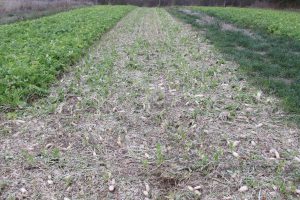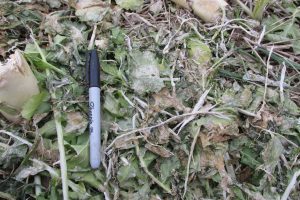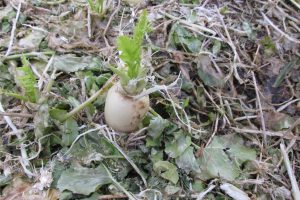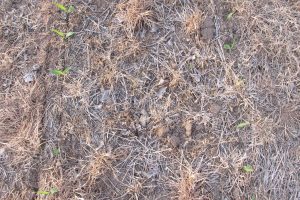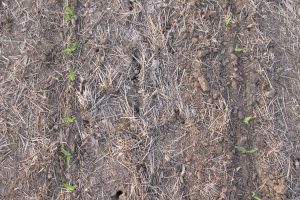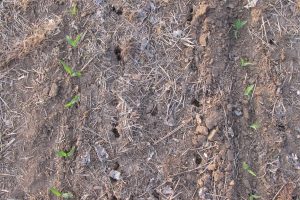Final Report for FNC14-979
Project Information
This project is investigating the efficacy of radish biomass management on slug and nematode populations and the impact on yield of no-till corn.
Use of improved, proprietary varieties of oilseed radish such a “Tillage” and “Groundhog” for cover crops has seen explosive growth and presumably has contributed to sustainability by positively affecting soil and water quality. However, experience indicates the potential for negative pest interactions, specifically the ability of radishes to create ideal habitat for slugs. These pests can devastate stands of subsequent crops, especially under no-till conditions, and there’s no reliable control method.
Radishes may contain a built-in control method for slugs if managed for this purpose. As members of the mustard family, they produce glucosinolates which are converted to allyl-isothiocyanate upon plant decomposition. Mechanical disruption of cells (such as chopping the cover crop) may produce lethal concentrations of allyl-isothiocyanate to reduce pest populations. This is a common component of biofumigation, but is frequently followed by incorporation of plant residues and commonly, sealing the soil surface with plastic. Common wisdom and to a lesser extent, science suggests this step is necessary to maintain concentrations of the mustard gas due to its volatility. Incorporation of residues also requires tillage so is at cross purposes to no-till production. It’s also possible that destruction of ideal slug habitat may reduce over-wintering populations and egg production. This may be the case where vegetation is chopped, allowing the biomass and soil surface to dry.
In field trials, we are investigating the impact of radish management on pest populations, soil protection and corn performance. Treatments following wheat harvest include no cover crop, unmanaged radish and radish-managed (chopped with a flail chopper in early November). From the one and one-half experimental cycles completed we’ve found chopping radish with a flail chopper produces a uniform residue mat on the surface and post planting (corn) residue is similar between chopped and unchopped residue. Additional cycles will be completed over the next two years to further determine efficacy against pests.
Introduction:
Use of improved, proprietary varieties of oilseed radish such a “Tillage” and “Groundhog” for cover crops has seen explosive growth in the past few years and industry representatives claim millions of acres are planted in the upper mid-west in any given year (J. Simon, Partners in Progress Seed, Sun Prairie, WI, personal communication). Undoubtedly this growth in cover crop use has benefited the sustainability of agriculture by positively affecting soil quality, but experience indicates the potential for negative pest interactions, specifically the ability of radishes to create ideal habitat for slugs. These pests can devastate stands of subsequent crops, especially under no-till conditions, and we don’t have reliable control methods other than avoidance and helping the new crop out-grow its period of susceptibility early in the growing season. Rank fall growth maintains high relative humidity under the canopy, creating an ideal environment for slug growth and reproduction, the mustard family in general is a known host for slugs and the nature of the vegetation may create an ideal over-wintering habitat.
Radishes may contain a built-in control method for slugs if managed for this purpose. All members of the mustard family produce glucosinolates which are converted to allyl-isothiocyanate upon plant decomposition. This chemical is similar to methyl iosthiocyanate, the active ingredient in the chemical fumigant Metam Sodium which is routinely used a biocide in vegetable production. Conversion of glucosinolates to allyl-isothiocyanate is a purely chemical reaction and depends on cell rupture. This happens naturally as tissues decompose but the concentration of allyl-isothiocyanate may be too low to produce lethal effects on target organisms with natural decomposition. Also, glucosinolates are only produced in green material, not plant roots so the impact on soil-dwelling pests may be minimal.
Mechanical disruption of cells (such as chopping the cover crop) may produce lethal concentrations of allyl-isothiocyanate to reduce pest populations. This is a common component of biofumigation, but is frequently followed by incorporation of plant residues and commonly, sealing the soil surface with plastic. Common wisdom and to a lesser extent, science suggests this step is necessary to maintain concentrations of the mustard gas because it’s highly volatile. Incorporation of residues requires tillage so is at cross purposes to no-till production.
It’s also possible that destruction of ideal slug habitat may reduce over-wintering populations and egg production. This may be the case where vegetation is chopped, allowing the biomass and soil surface to dry.
- To determine if manipulated (chopped) radish cover crop residues suppress slug and nematode populations and their damage to the subsequent corn crop;
- To determine if manipulation (chopping) of the radish cover crop reduce its ability to protect the soil overwinter (does it reduce the conservation performance of the cover crop?)
Research
This field-study was conducted in Southeast Wisconsin near East Troy on a fox silt loam soil in fields with long-term no-till history. Experimental conditions and dates can be found in table 1. Treatments included:
- No cover crop (control);
- Radish cover crop, unmanaged;
- Radish cover crop, managed
and were established following wheat harvest and a short fallow period to encourage volunteer wheat to emerge which was terminated with glyphosate (0.56 lb. ai. /acre; AMS 16 lb./ 100 gal.). Wheat straw was chopped back onto the field. Oilseed radish (cv. Tillage Radish) was no-till drilled at 8 lb./acre in 7.5 inch rows and allowed to grow into early November when the managed radish treatment was chopped with a flail chopper, 2.5 inches above the soil surface. Before chopping, samples were taken from a sampling square, cut at 2.5 inches to estimate the amount of biomass being chopped to form the mat. Subsamples were analyzed for dry matter (DM), carbon (C) and nitrogen (N).
Corn was no-till planted the following spring after burn-down herbicide application (glyphosate, 0.84 lb. ai. /acre; AMS 16 lb./ 100 gal) and broadcast N (urea, 150 lb. N/ acre) application. Corn (O’Brien OB611) was planted at a rate of 32,000 kernels/ acre in 30-inch rows at a 2-inch depth with row-cleaners adjusted to remove residue with minimal soil disturbance. Weed control consisted of a premergence application of atrazine + metolachlor (1.0+1.7 lb. a.i./ acre).
Residue cover was estimated immediately after planting using the line-transect methods. Two 40-foot measurements were taken per plot counting only volunteer wheat or radish residue and averaged. Root lesion (Pratylenchus spp) nematode populations were estimated by sampling soil to a depth of 8 inches, 10 cores per plot which was mixed to form a composite sample for each plot. The top 2 inches of each core was discarded per lab recommendations. Samples were submitted to the University of Wisconsin Nematode Diagnostic Lab http://labs.russell.wisc.edu/uw-nematode-diagnostic-lab/ for extraction and measurement. Populations are expressed as number per 100 cc soil.
Stand counts were taken 1-week after emergence in the two-center harvest rows, 80 row-feet total. Slug feeding was monitored on a weekly basis in the same rows by counting the number of plants with tissue damage. This continued throughout June until corn was no-longer susceptible to damage. Yield was estimated by hand harvesting ears from the 2 center harvest rows. Yield is reported at 15% moisture.
The experimental design was a randomized complete block with four replicates. Plot size was 10 x 40 feet. Data were subject to analysis of variance procedures and means separated by a least significant difference at the 5 percent level where significant treatment differences occurred.
Residue
Radish biomass yield, both fresh weight and DM were substantially greater in 2015, despite a later planting date and lower post-planting precipitation (Table 2). This is attributed to less volunteer wheat in 2015 which was apparently outcompeted and smothered by radish as evident by no over-wintered wheat in either treatment. We have observed this in other trials where radish is planted in pure stands at higher planting rates.
Chopping radish biomass did not significantly affect surface residue at corn planting (Table 3). The chopped residue decomposes rapidly (photos) so soil protection is reduced in fall prior to freeze-up but equalized with unmanaged residue by spring due to overwinter decomposition. In general, we’ve observed very low spring reside amounts when radish is established in pure stand. Plants whose crowns were not damaged by chopping did exhibit regrowth but the contribution is minimal due to colder temperatures at that point in the growing season. Post-planting residue cover in the no radish treatment was significantly greater because of volunteer wheat and above the NRCS performance criteria of 30%. Actual surface residue in all treatments was greater than reported because other crop residue including wheat straw was not counted. Had it been included, both radish treatments probably would have exceeded 30% so the lack of radish residue is less of a concern.
Slugs
Treatments had no effect on the percent of corn plants exhibiting feeding damage (Table 3.) which was very low. Slugs were also not evident in the plots during rating which was conducted early in the morning. Possible causes include low populations and/or rapid growth in June, allowing corn to outgrow the critical period for slug damage. This was driven by ample post emergence precipitation, 5.41 inches from ten events to July 1 at which point corn was beyond 6 feet in height.
Slug feeding on radish was not evident in 2015 and is readily apparent if present during biomass sampling. An attempt was made to measure relative slug populations using mustard extraction (Gavin et al, 2005) which produced no results. Its possible slug populations were initially low in the field where cycle 1 was completed, either inherently or due to dry conditions in 2014. Slug damage to corn is usually experienced it some degree in all fields every year so this result is unexpected. Slug feeding on radish was noted in 2016 during biomass sampling so this trial may yield different results in Cycle 2. Slug blankets (Liphatech, Milwaukee WI 53209) will be used in 2017 and 2018 (cycles 2 and 3) to estimate relative slug populations. This will supplement actual feeding ratings.
Nematodes
Values exceeding 200 per 100 cc soil are considered “high damage potential” for corn, which is the case for this site. Treatments did not significantly affect nematodes populations but the data shows a trend for a reduction with the managed radish treatment (Table 3). Nematode populations can be highly aggregated, and spatial analysis of the data indicate populations were much lower in one of the replicates (rep effect: p>F =0.1432) which may skew the results. Ranking of the treatments by replicate indicated consistently lower numbers in the managed radish treatment suggesting efficacy. More years of data are needed to draw conclusions. Future cycles will measure changes in pest populations (pre-to post treatment) by plot to account for potential heterogeneity in populations in determining efficacy.
Corn
Treatments did not affect emergence (data not shown), final stand or yield (table 3). Yields are well below average and treatment effects (direct rotational or pest interactions) may have been masked by moisture deficiency during pollination which was incomplete resulting in small, poorly filled ears.
References:
Gavin, W.E., G.M. Banowetz, J.J. Steiner, S.M. Griffith and G.W. Mueller-Warrant. 2005. Fast and accurate method for estimating slug densities. (oregonstate.edu/pub/2005/11.pdf).
Impact of Results/Outcomes
With SARE funding I completed one and one-half experimental cycles of the planned two. Trial initiation was delayed by dry conditions in 2014 preventing the planned establishment of radish. With the experiences gained I will/ have made slight modifications to techniques to improve measurements and the information this trial will generate. I will complete an additional one and a half cycles for a total of 3 complete cause-effect cycles.
Educational & Outreach Activities
Participation Summary:
I held a field day on September 8, 2016, combining it with the annual Michael Fields Agricultural Institute's Cover Crop field day. Ten individuals attended, could see both phases on the trial- radish and corn, learned of preliminary results and saw other cover crop work and practices on my farm. I also used the plots as a teaching tool for the Institute's Garden Student Internship program. The topic of biocontrol is of great interest to them because both root lesion nematodes and slugs are of great concern in organic fresh market vegetable production. An announcement for the field day was submitted to NCR-SARE for promotion.
In 2017 this trial will be part of a professional development learning event for conservation agency personnel, tentatively scheduled for October.
With sufficient data I will also produce a research finding factsheet which will be available through the Michael Fields Agricultural Institute and also on the UW-Extension Cover Crop website, http://fyi.uwex.edu/covercrop/ This site is currently under development and is intended to serve as a clearing house for all cover crop information in Wisconsin.
Project Outcomes
Potential Contributions
Although more data is needed, flail chopping radish works for creating a residue mat and destroying pest habitat (two-years’ experience) One-years data suggests it has little impact on conservation performance compared to unmanaged radish especially in concert with extant residue in fields with long-term no-till history.
Pest implications are important. One-years data suggests potential efficacy against nematodes. This is important because they’re a wide-spread pest causing hidden yield loss with few control options, products (mostly rootworm insecticides) which are older and of higher toxicity.
Future Recommendations
None at this time due to limited data.
